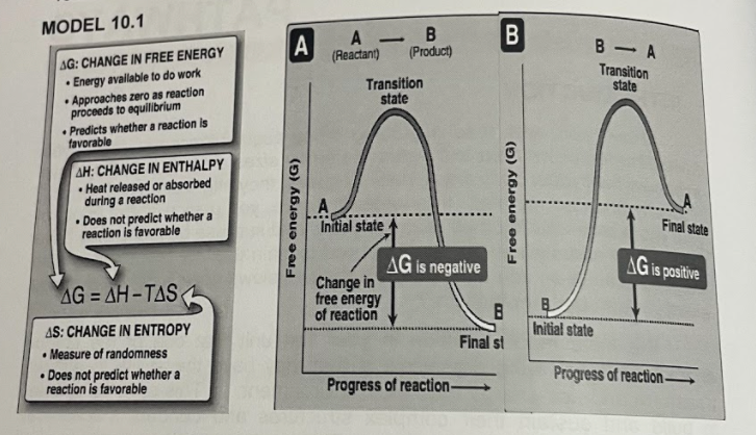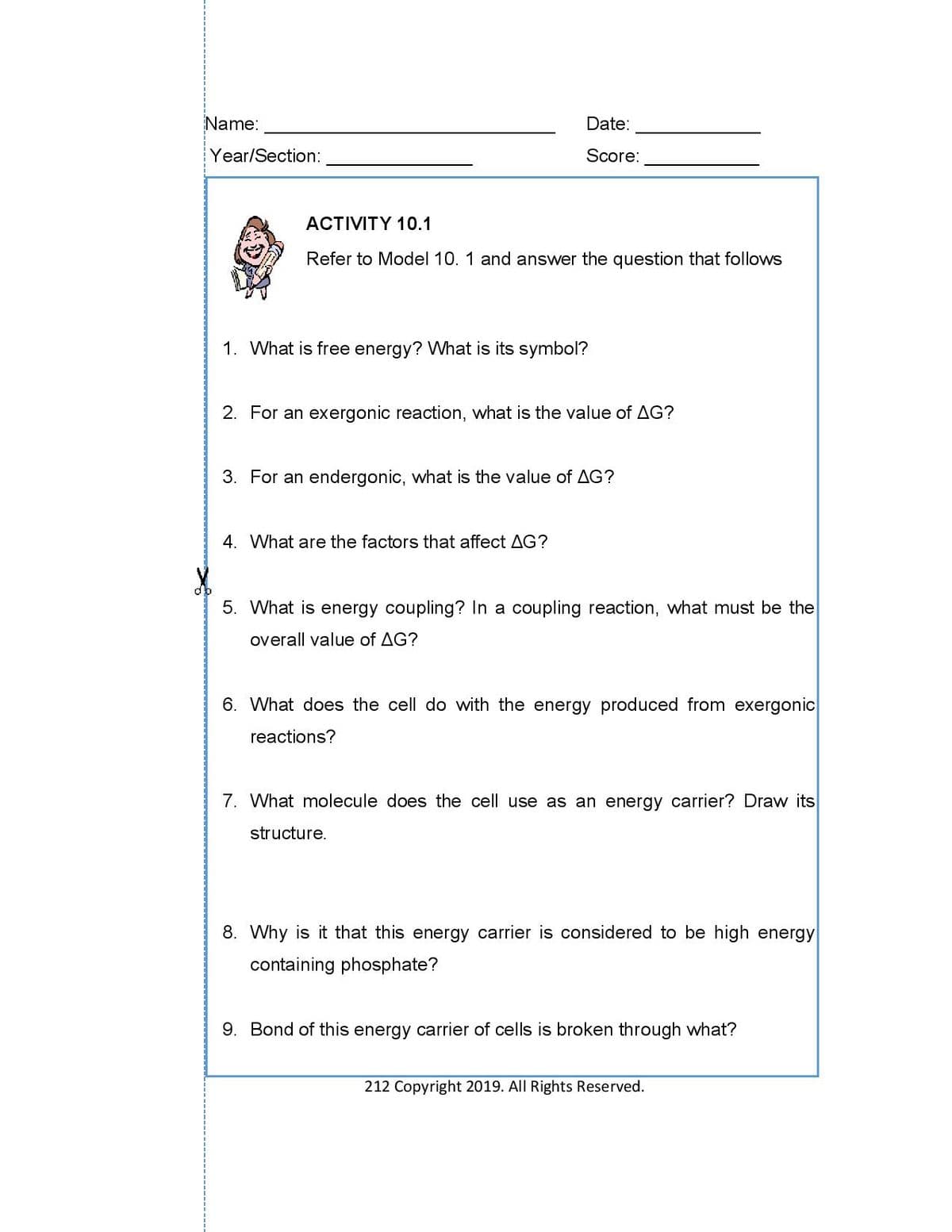MODEL 10.1 A (Reactant) - B- A AG: CHANGE IN FREE ENERGY Energy available to do work Approaches zero as reaction proceeds to equillibrium • Predicts whether a reaction is favorable (Product) Transition state Transition state AH: CHANGE IN ENTHALPY • Heat released or absorbed during a reaction • Does not predict whether a reaction is favorable A Initial state Final state AG is negative AG is positive Change in free energy of reaction AG = AH-TAS %3D AS: CHANGE IN ENTROPY Initial state Final st Measure of randomness • Does not predict whether a reaction is favorable Progress of reaction- Progress of reaction– B (5) KBJoue 00 Free energy (G) Name: Date: Year/Section: Score: ACTIVITY 10.1 Refer to Model 10. 1 and answer the question that follows 1. What is free energy? What is its symbol? 2. For an exergonic reaction, what is the value of AG? 3. For an endergonic, what is the value of AG? 4. What are the factors that affect AG? 5. What is energy coupling? In a coupling reaction, what must be the overall value of AG? 6. What does the cell do with the energy produced from exergonic reactions? 7. What molecule does the cell use as an energy carrier? Draw its structure. 8. Why is it that this energy carrier is considered to be high energy containing phosphate? 9. Bond of this energy carrier of cells is broken through what? 212 Copyright 2019. All Rights Reserved.
MODEL 10.1 A (Reactant) - B- A AG: CHANGE IN FREE ENERGY Energy available to do work Approaches zero as reaction proceeds to equillibrium • Predicts whether a reaction is favorable (Product) Transition state Transition state AH: CHANGE IN ENTHALPY • Heat released or absorbed during a reaction • Does not predict whether a reaction is favorable A Initial state Final state AG is negative AG is positive Change in free energy of reaction AG = AH-TAS %3D AS: CHANGE IN ENTROPY Initial state Final st Measure of randomness • Does not predict whether a reaction is favorable Progress of reaction- Progress of reaction– B (5) KBJoue 00 Free energy (G) Name: Date: Year/Section: Score: ACTIVITY 10.1 Refer to Model 10. 1 and answer the question that follows 1. What is free energy? What is its symbol? 2. For an exergonic reaction, what is the value of AG? 3. For an endergonic, what is the value of AG? 4. What are the factors that affect AG? 5. What is energy coupling? In a coupling reaction, what must be the overall value of AG? 6. What does the cell do with the energy produced from exergonic reactions? 7. What molecule does the cell use as an energy carrier? Draw its structure. 8. Why is it that this energy carrier is considered to be high energy containing phosphate? 9. Bond of this energy carrier of cells is broken through what? 212 Copyright 2019. All Rights Reserved.
Biochemistry
9th Edition
ISBN:9781319114671
Author:Lubert Stryer, Jeremy M. Berg, John L. Tymoczko, Gregory J. Gatto Jr.
Publisher:Lubert Stryer, Jeremy M. Berg, John L. Tymoczko, Gregory J. Gatto Jr.
Chapter1: Biochemistry: An Evolving Science
Section: Chapter Questions
Problem 1P
Related questions
Question
Answer for the number 6 question, Thank you. No need for long explanation.

Transcribed Image Text:MODEL 10.1
A
(Reactant)
-
B- A
AG: CHANGE IN FREE ENERGY
Energy available to do work
Approaches zero as reaction
proceeds to equillibrium
• Predicts whether a reaction is
favorable
(Product)
Transition
state
Transition
state
AH: CHANGE IN ENTHALPY
• Heat released or absorbed
during a reaction
• Does not predict whether a
reaction is favorable
A
Initial state
Final state
AG is negative
AG is positive
Change in
free energy
of reaction
AG = AH-TAS
%3D
AS: CHANGE IN ENTROPY
Initial state
Final st
Measure of randomness
• Does not predict whether a
reaction is favorable
Progress of reaction-
Progress of reaction–
B
(5) KBJoue 00
Free energy (G)

Transcribed Image Text:Name:
Date:
Year/Section:
Score:
ACTIVITY 10.1
Refer to Model 10. 1 and answer the question that follows
1. What is free energy? What is its symbol?
2. For an exergonic reaction, what is the value of AG?
3. For an endergonic, what is the value of AG?
4. What are the factors that affect AG?
5. What is energy coupling? In a coupling reaction, what must be the
overall value of AG?
6. What does the cell do with the energy produced from exergonic
reactions?
7. What molecule does the cell use as an energy carrier? Draw its
structure.
8. Why is it that this energy carrier is considered to be high energy
containing phosphate?
9. Bond of this energy carrier of cells is broken through what?
212 Copyright 2019. All Rights Reserved.
Expert Solution
This question has been solved!
Explore an expertly crafted, step-by-step solution for a thorough understanding of key concepts.
Step by step
Solved in 3 steps

Recommended textbooks for you

Biochemistry
Biochemistry
ISBN:
9781319114671
Author:
Lubert Stryer, Jeremy M. Berg, John L. Tymoczko, Gregory J. Gatto Jr.
Publisher:
W. H. Freeman

Lehninger Principles of Biochemistry
Biochemistry
ISBN:
9781464126116
Author:
David L. Nelson, Michael M. Cox
Publisher:
W. H. Freeman

Fundamentals of Biochemistry: Life at the Molecul…
Biochemistry
ISBN:
9781118918401
Author:
Donald Voet, Judith G. Voet, Charlotte W. Pratt
Publisher:
WILEY

Biochemistry
Biochemistry
ISBN:
9781319114671
Author:
Lubert Stryer, Jeremy M. Berg, John L. Tymoczko, Gregory J. Gatto Jr.
Publisher:
W. H. Freeman

Lehninger Principles of Biochemistry
Biochemistry
ISBN:
9781464126116
Author:
David L. Nelson, Michael M. Cox
Publisher:
W. H. Freeman

Fundamentals of Biochemistry: Life at the Molecul…
Biochemistry
ISBN:
9781118918401
Author:
Donald Voet, Judith G. Voet, Charlotte W. Pratt
Publisher:
WILEY

Biochemistry
Biochemistry
ISBN:
9781305961135
Author:
Mary K. Campbell, Shawn O. Farrell, Owen M. McDougal
Publisher:
Cengage Learning

Biochemistry
Biochemistry
ISBN:
9781305577206
Author:
Reginald H. Garrett, Charles M. Grisham
Publisher:
Cengage Learning

Fundamentals of General, Organic, and Biological …
Biochemistry
ISBN:
9780134015187
Author:
John E. McMurry, David S. Ballantine, Carl A. Hoeger, Virginia E. Peterson
Publisher:
PEARSON